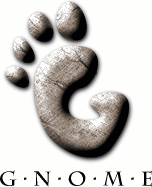|
|
|
|





Gnome is desktop for Unix and GNU/Linux delivering a high level of usability and interoperability. The Gnome Foundation, initiated in August 2000, brought together many of the major Unix vendors, including Sun Microsystems, IBM, HP and Compaq, to support the further development of Gnome. Sun, for example, has identified the Gnome desktop as the standard for Solaris, one of the most popular commercial versions of Unix.

Gnome, an abbreviation for the GNU Network Object Model Environment, is a component-based system built around standards such as XML and CORBA. It offers a standard for look-and-feel and provides a platform for applications to share resources (like including graphics generated using the Guppi application in a spreadsheet within Gnumeric).
While we refer to a common look-and-feel for Gnome there is much more. While all Gnome applications have the same look-and-feel, you can choose the look-and-feel (usually referred to as the theme) to suit your own style. The variety of different themes is extensive and includes themes that can make your desktop appear like MS-Windows or Apples Macintosh, to name just two. Once you choose a theme all of the Gnome applications will use that theme immediately. You can change themes (using the Toolbox) at any time. The theme used in this book is the Default theme that is similar to the HeliX theme but using a lighter grey in the background (and hence more suitable for the screen images used here).
In this chapter we begin with the basics of the Gnome desktop and walk you though interacting with Gnome applications, including menus, toolbars and dialogs. This is followed by reference sections identifying Gnome applications.